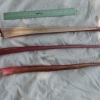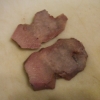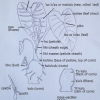Use As Food
Both as poi and as table taro, mainly for home consumption; formerly this variety was used as an offering to the gods.
Distribution
Found scattered throughout the islands in small patches under both lo‘i (wetland) and māla (upland, dryland) culture.
General Characteristics
Medium in height to tall, moderately spreading, maturing within 8 to 12 months, producing from 5 to 10 ‘ohā; identified by the brilliant light red Hā (Petiole).
Ha (Petiole)
75 to 100 cm. long, brilliant light red occasionally faintly diffused with yellowish-green. White stripes. Indistinctly dark reddish at lihi (stem edge), a dark red ring at kōhina (base) with dark pink for 3 to 5 cm. above the base.
Lau or Lu'au(Leaf Blade)
35 to 45 cm. long, 25 to 35 cm. wide, 25 to 35 cm. from tip to base of sinus (māwae), egg-shaped (ovate), dark glossy green with bluish cast; piko conspicuous, purple; veins reddish on lower surface; round leaf section (lobes) obtuse, wave-like (undulate) on margins, with narrow lihi māwae (sinus).
'I'o kalo (Corm)
Flesh white with pinkish tinge, especially near top (apex), the fibers yellowish; skin pinkish-lilac.
Pua (Flower)
Hā (peduncle) light red; flower cover (spathe) 21 to 23 cm. long, the lower tubular portion 3 to 4 cm. long, dark reddish-purple, tightly rolled, the upper portion dark yellow with tinge of red throughout, dark red with dark red streaks at margins, light red inside, partially open near constriction (skinny part of flower) at maturity; spadix (spike of flower) about 7 cm. long, the sterile appendage (tip of flower's spike) 4 to 5 mm. long, not clearly differentiated from flower sex organ (staminate) portion.
Remarks
This is one of the most brilliantly colored of the taros. 48. ‘Ula‘ula Kūmū and 50. ‘Ula‘ula Moano are similar in appearance and both named after fish. The difference is ‘Ula‘ula Kūmū's Hā (petiole) has white stripes, and ‘Ula‘ula Moano's Hā has green stripes. We call these two brothers since they start with "U."


























